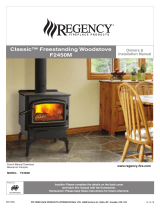
-3-
READ THESE RULES AND THE INSTRUCTIONS CAREFULLY
1. Check with local codes. The installation must
comply with their rulings. Observe closely the
clearances to combustibles.
2. Do not install this heater in a mobile home or trailer.
3. Always connect this heater to a chimney and
vent to the outside. Never vent to another room or
inside a building. DO NOT CONNECT THIS UNIT TO A
CHIMNEY FLUE SERVING ANOTHER APPLIANCE.
4. Do not connect a wood burning heater to a Type
B gas vent. This is not safe and is prohibited by
the National Fire Protection Association Code.
This heater requires approved masonry or UL,
ULC Listed Residential Type and Building Heating
Appliance Chimney. Use a 6" diameter chimney,
or larger, that is high enough to give a good draft.
5. Be sure that your chimney is safely constructed and
in good repair. Have the chimney inspected by
the Fire Department or a qualied inspector. Your
insurance company may be able to recommend
a qualied inspector.
6. Inspect chimney connector and chimney twice
monthly during the heating season for any deposit
of creosote or soot which must be removed (see
the "Woodstove Utilization" section of this manual).
7. Provide air for combustion from outside the house
into the room where the heater is located. If the
intake is not in the same room, air must have free
access into the room.
8. To prevent injury, do not allow anyone to use this
heater who is unfamiliar with the correct operation
of the heater.
9. For further information on using your heater safely,
obtain a copy of the National Fire Protection
Association (NFPA) publication "Using Coal and
Wood Stoves Safely" NFPA No. HS-10-1978. The
address of the NFPA is Batterymarch Park, MA
02269.
• For more information on a Canadian Installation,
obtain a copy of CAN/CSA - B365 - M91 Installation
Code for Solid-Fuel-Burning Appliances and
Equipment.
10. CAUTION - The special paints used on your heater
may give off some smoke while they are curing
during the rst few res. Build small res at rst.
Children and people/animals with lung problems
should take caution during the curing process.
11. CARING FOR PAINTED PARTS - This heater has
a painted jacket which is durable but it will not
stand rough handling or abuse. When installing
your heater, use care in handling. Clean with soap
and warm water when heater is not hot. DO NOT
use any acids or scouring soap, as these wear and
dull the nish. PAINT DISCOLORATION WILL OCCUR
IF THE HEATER IS OVERFIRED. FOLLOW OPERATING
INSTRUCTIONS CAREFULLY.
12. All persons, especially children, should be alerted
to hazards from high surface temperatures and
kept away while in operation. Small children
should not be left unsupervised when in the room
with the heater.
13. Keep the area adjacent to the heater free from
all combustible materials, gasoline, and other
ammable vapors.
14. This heater should not be used as a primary source
of heat.
15. CAUTION DO NOT CONNECT TO OR USE IN
CONJUNCTION WITH ANY AIR DISTRIBUTION
DUCTWORK
Safety Rules
SAFETY NOTICE: If this heater is not properly installed, a house re may result. For your safety, follow the installation
directions. Contact local building or re ofcials about restrictions and installation inspection requirements in
your area.
CAUTION! Do not touch the heater until it has cooled.
NOTE: FOR YOUR SAFETY, WE RECOMMEND INSTALLING SMOKE DETECTORS IN YOUR HOME IF NOT ALREADY
INSTALLED.




















